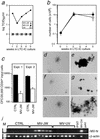Targeting and hematopoietic suppression of human CD34+ cells by measles virus
- PMID: 12050376
- PMCID: PMC136250
- DOI: 10.1128/jvi.76.13.6636-6642.2002
Targeting and hematopoietic suppression of human CD34+ cells by measles virus
Abstract
The major cause of mortality in measles is generalized suppression of cell-mediated immunity that persists following virus clearance and results in secondary infections. The mechanisms contributing to this long-term immunosuppression are not clear. Herein we present evidence that measles virus (MV) disrupts hematopoiesis by infecting human CD34+ cells and human bone marrow stroma. MV infection does not affect the hematopoietic capability of hematopoietic stem cells (HSCs) directly; rather, the infection impairs the ability of stroma to support development of HSCs. These results suggest that MV-mediated defects in hematopoiesis contribute to the long-term immunosuppression seen in measles.
Figures



References
-
- Almeida, G., C. D. Porada, S. St. Jeor, and J. L. Ascensao. 1994. Human cytomegalovirus alters interleukin-6 production by endothelial cells. Blood 83:370-376. - PubMed
-
- Bahner, I., K. Kearns, S. Coutinho, E. H. Leonard, and D. B. Kohn. 1997. Infection of human marrow stroma by human immunodeficiency virus-1 (HIV-1) is both required and sufficient for HIV-1 induced hematopoietic suppression in vitro: demonstration by gene modification of primary human stroma. Blood 90:1787-1798. - PubMed
-
- Biron, C. A. 1994. Cytokines in the generation of immune responses to, and resolution of, virus infection. Curr. Opin. Immunol. 6:530-538. - PubMed
Publication types
MeSH terms
Substances
Grants and funding
LinkOut - more resources
Full Text Sources
Medical

